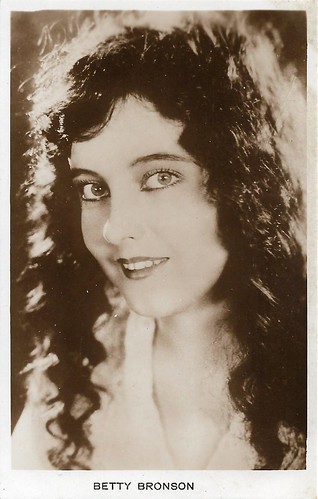
British Real Photograph postcard.
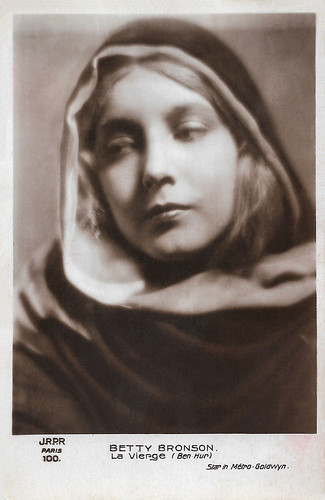
French postcard by JRPR, Paris, no. 100. Photo: Metro-Goldwyn. Betty Bronson as The Holy Virgin in Ben-Hur (Fred Niblo, 1925).

French postcard by Editions Cinémagazine, no. 226.
Betty Bronson Mania
Elizabeth Ada 'Betty' Bronson was born in Trenton, New Jersey, in 1906, to Frank and Nellie Smith Bronson. She moved to East Orange, New Jersey and attended East Orange High School until she convinced her parents to let her move to California to aid her career in films. Subsequently, the entire family moved to California. Bronson began her film career at the age of 16 with a bit part in the silent romantic drama Anna Ascends (Victor Fleming, 1922). Alice Brady reprises in the film her starring role from the 1920 Broadway play of the same name about a working-class Syrian American waitress who through hard work 'ascends' the social and economic ladder and becomes successful in the United States. It was followed by more small roles in the silent romantic drama Java Head (George Melford, 1923) starring Leatrice Joy and Jacqueline Logan, the drama His Children's Children (Sam Wood, 1923) starring winsome Bebe Daniels, and The Eternal City (George Fitzmaurice, 1923), starring Barbara La Marr.
At 17, Betty was interviewed by J. M. Barrie, author of 'Peter Pan'. Although the role had been sought by such established actresses as Gloria Swanson and Mary Pickford, Barrie personally chose Bronson to play the lead in the film adaptation of his work, Peter Pan (Herbert Brenon, 1924). She appeared alongside actresses Mary Brian (Wendy Darling) and Esther Ralston (Mrs. Darling), both of whom remained lifelong friends. Ernest Torrence played Captain Hook, Virginia Browne Faire was Tinker Bell, and Chinese-American actress Anna May Wong played the Indian princess Tiger Lily. The film was celebrated at the time for its innovative use of special effects, mainly to show Tinker Bell.
Peter Pan (Herbert Brenon, 1924) closely follows the plot of the original play and even goes so far as to incorporate much of its original stage dialogue in the intertitles. Added scenes include Nana the dog pouring out Michael's medicine and giving him a bath, and Nana bursting into the home at which a party is being given, to warn Mr. and Mrs. Darling that Peter Pan and the Darling children are flying around the nursery. Like the original play and several other versions, unlike the 1953 Disney film, the 1924 version makes it clear that Wendy harbours a romantic attachment to Peter. Still, Peter only thinks of her as his mother.
Camille Scaysbrook at IMDb: "Betty's beautifully expressive performance and unsophisticated looks earned her instant success. For the year following Peter Pan's release, Bronson-mania easily equalled the sort of hysteria previously reserved only for Pickford." Bronson starred in such films as the comedy Are Parents People? (Malcolm St. Clair 1925) with Florence Vidor and Adolphe Menjou, and Not So Long Ago (Sidney Olcott, 1925) with Ricardo Cortez. She had a small but significant part as The Holy Virgin Mary in the silent film adaptation of Ben-Hur (Fred Niblo, 1925), with Ramon Novarro in the title role.
In 1925, she starred in another J. M. Barrie story, A Kiss for Cinderella (Herbert Brenon, 1925) with Esther Ralston and Tom Moore, an artfully made film that failed at the box office. In only one year the public taste had changed so much as to render the sentimental entertainment of yesteryear obsolete. Audiences were suddenly more interested in the more adult charms of flappers such as Clara Bow and Colleen Moore. Betty, too, was re-launched as a flapper, sophisticate and occasional period dame in such films as the comedy The Cat's Pajamas (William A. Wellman, 1926) with Ricardo Cortez and Arlette Marchal, and the successful escapist-romance Paradise (Irvin Willat, 1926) with Milton Sills. Her career was moderately successful but her superstardom had subsided.

German postcard by Ross Verlag, no. 1095/1, 1927-1928. Photo: Paramount-Film.
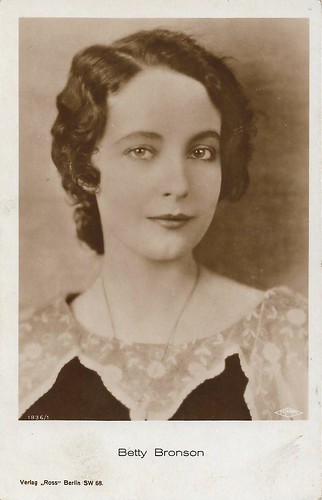
German postcard by Ross Verlag, no. 1836/1, 1927-1928. Photo: Fanamet.

German postcard by Ross Verlag, no. 2006/1, 1927-1928. Photo: First National / Fanamet. Betty Bronson and Milton Sills acted together in Paradise (Irvin Willat, 1926).

German postcard by Ross Verlag, no. 3804/1, 1928-1929. Photo: Paramount Pictures.
An excellent voice
Betty Bronson made a successful transition into sound films. She sparkled and demonstrated an excellent voice in The Singing Fool (Lloyd Bacon, 1928), co-starring Al Jolson. The part talking film followed Jolson's previous film, The Jazz Singer (Alan Crosland, 1927). The Singing Fool is credited with helping to cement the popularity of American films of both sound and the musical genre. Bronson also appeared in the sequel, Sonny Boy (Archie Mayo, 1929), with Davey Lee and Edward Everett Horton.
Bronson was the leading lady opposite vaudeville star Jack Benny in the romantic drama The Medicine Man (Scott Pembroke, 1930). She played the daughter of a shopkeeper who falls in with the leader of a travelling medicine show.
Bronson continued acting until 1933 when she married Ludwig Lauerhass, a well‐to‐do North Carolinian, with whom she had one child, Ludwig Lauerhass, Jr, who later became a lecturer in history emeritus at the University of California, Los Angeles. She did not appear in films again until Yodelin' Kid from Pine Ridge (Joseph Kane, 1937) starring singing cowboy Gene Autry.
In the 1960s, she appeared in episodic television and feature films, such as in Frank Capra's final film, Pocketful of Miracles (1961), starring Bette Davis and Glenn Ford, and Samuel Fuller's Neo-Noir The Naked Kiss (1964). Her last screen appearance was an uncredited part in the television biopic Evel Knievel (Marvin J. Chomsky, 1971), starring George Hamilton as motorcycle daredevil Evel Knievel.
In 1971, Betty Bronson died after a protracted illness in Pasadena, California, and was interred at Forest Lawn Memorial Park in Glendale, California. She was 64 and survived by her son, a brother, a sister, and two grandchildren.
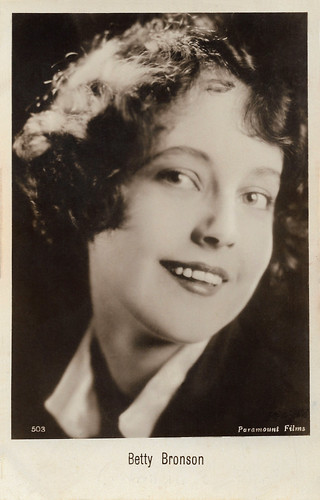
Italian postcard by G.B. Falci Editore, Milano, no. 503. Photo: Paramount Films.
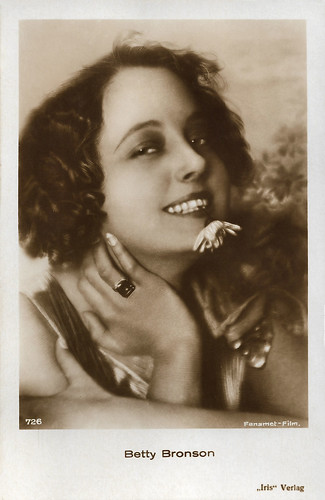
Austrian postcard by Iris Verlag, no. 726. Photo: Fanamet-Film.

French postcard. This is not May McAvoy but Betty Bronson as the Virgin Mary in Ben-Hur (Fred Niblo 1925). Publicity for the Cinéma Madeleine.
Sources: Camille Scaysbrook (IMDb), AllMovie, Wikipedia and IMDb.
This post was last updated on 13 August 2023.
No comments:
Post a Comment